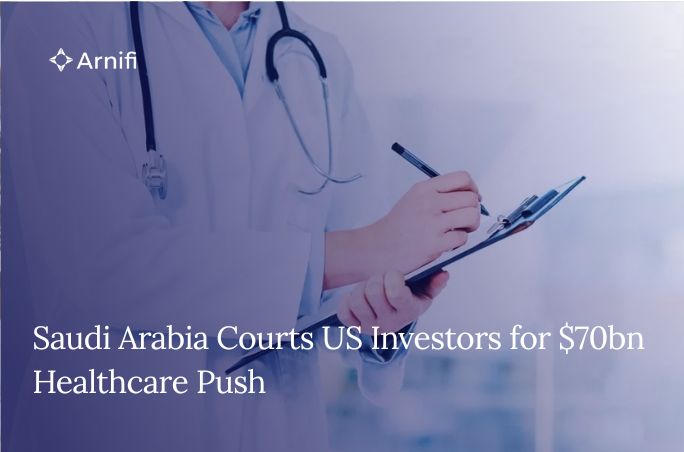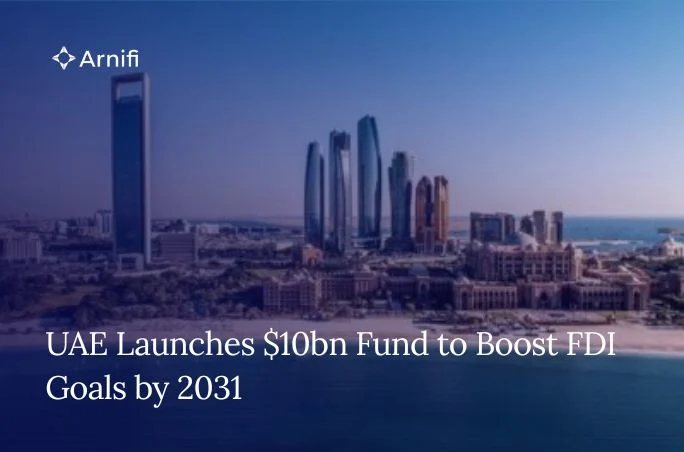Saudi Arabia Lays Out Big-Ticket Healthcare Pitch to US Investors
by
Ishika Bhandari
Nov 24, 2025  7 MIN READ
7 MIN READ

Table of contents
- A Strategic Pitch for Healthcare Investment
- Where the Money Is: Pharma & Devices
- Industrial Transformation: Technology + Policy Alignment
- Vision 2030: Strategic Motivation
- Investor Incentives and Reforms
- Broader Economic Impact
- Why the US Matters
- Driving Forces Behind the Opportunity
- Risks & Challenges Ahead
- Why This Matters
- Looking Ahead: What to Expect
- Conclusion
In a bold call for greater US investment, Saudi Arabia used the 2025 US-With a bold eye toward more US investment, Saudi Arabia used the platform of the 2025 US-Saudi Investment Forum to make a sweeping case: today, the healthcare market is approximately $70 billion and walking out of the stage looking for partners to develop it, especially the $11.5 billion pharmaceutical industry and the currently valued at $6.5 billion, medical devices part of it.
The Saudi Arabian Minister of Industry and Mineral Resources, Bandar Alkhorayef, made this comment in Washington, D.C., at the forum with business leaders and investors present. The Kingdom’s ideas create major opportunities for global companies in the fields of pharmaceuticals, vaccines, and medical manufacturing. This placed healthcare as a central pillar in the Saudi economic transformation agenda.
A Strategic Pitch for Healthcare Investment
Under the banner of “Advancing Healthcare Delivery Through Innovation and Biotechnology,” Alkhorayef sketched an image in which Saudi Arabia will not merely build up its own domestic production capacity; it will deepen collaboration with global biopharma and med-tech firms. Their aim is clear: to localise industrial capacity, build supply-chain resilience, and boost national health security by reducing dependence on imports.
He highlighted that such initiatives receive institutional backing through the Vaccine & Biopharmaceutical Industry Committee, which is in the midst of policy reforms to make the regulatory ecosystem more attractive, transparent, and supportive for investors.
This partially complements the wider public strategic initiatives of the Saudi government, especially the Local Content Program and Health Sector Transformation Program, which seek the empowerment of local capabilities in manufacturing health needs.
Where the Money Is: Pharma & Devices
According to Alkhorayef, three major verticals attract US investment:
- Pharmaceuticals: The Saudi pharma market is already estimated at $11.5 billion. He said international companies investing in the manufacturing of drugs, including in cutting-edge biologics and vaccines, would find good institutional support and demand.
- Vaccines & Biologics: Saudi Arabia is pushing through its biopharmaceutical committee to become self-reliant in vaccine production, which remains an absolute top priority because of global supply-chain vulnerabilities.
- Medical Devices: The medical-equipment industry has now grown to about $6.5 billion in value. This makes it fertile grounds for diagnostic tools, devices, and advanced medical technologies, according to Alkhorayef.
Industrial Transformation: Technology + Policy Alignment
Saudi Arabia’s pitch does not only cover market access, but it also implies speed in industrial transformation. In fact, it would be emphasized that the country is speeding up its industrial transformation through advanced technologies- such as artificial intelligence and Industry 4.0- in its manufacturing base.
After that, competitive energy costs, a growing digital infrastructure, and investor-friendly reforms are being put into place for streamlining foreign investment. The investor road map has been simplified from setting up operations to scaling capacity.
Senior leaders of the Saudi industry accompanied Alkhorayef at this forum. This includes Saleh Al-Solami, CEO of the National Industrial Development Center, showing how serious the Kingdom is towards making healthcare manufacturing one of the primary industrial priorities.
Vision 2030: Strategic Motivation
Thus, the investment mobilization campaign is intricately tied to Vision 2030, which is the long-term plan of Saudi Arabia for economic diversification from oil. Among the targets for Vision 2030 is localization in the pharmaceutical and medical industries through international partnerships, technology transfer, and strengthened regulatory frameworks.
That is how Saudi Arabia will not only reduce dependence on imported medicines and devices but also manufacture with a globally competitive capability. This push also supports its National Industrial Strategy that seeks localization of critical sectors, including health.
Investor Incentives and Reforms
Alkhorayef noted incentives to encourage foreign companies to invest, including:
- Policies that expedite business setup and cut red tape
- Frameworks to facilitate advanced technology transfer
- Transparent regulation that lowers risk for foreign pharmaceuticals and biotech companies
He added that Saudi Arabia is not just inviting investments, but is also laying down foundations to make that investment sustainable and scalable.
Broader Economic Impact
Beyond health, the minister framed this as a strategic economic opportunity. Thus, localizing pharmaceutical and medical manufacturing would serve multiple national objectives: public health security, generating high-value industrial jobs, and developing into a knowledge-based economy.
By attracting US and global companies, Saudi Arabia hopes to strengthen its position in global supply chains and produce more advanced health products domestically. It aims to get both economic and societal benefits from a modernized health-industrial base.
Why the US Matters
Washington has become the prime venue for selling all this, which emphasizes the US’s importance to Saudi Arabia in terms of the know-how, cash, and, most importantly, innovation-related investment. American biotech, pharma, and med-tech firms remain the gold standard of global industry, and as such, Riyadh clearly views them as partners in its industrial aspirations.
By the involvement of US companies, Saudi Arabia aims for more than just an inflow of capital but also a technological partnership, R&D partnerships, and knowledge of how to manufacture. It is also meant to assure investors that Saudi Arabia is serious about reform and long-term commitment.
Driving Forces Behind the Opportunity
The healthcare ambitions of Saudi Arabia have several structural tailwinds:
- Demographic shifts: A large and ageing population, with a rise in the incidence of chronic diseases, is creating demand for complex care.
- Healthcare digitization: The Kingdom’s healthcare IT market is growing fast, with good projections of CAGRs for the coming few years.
- Regulatory reform: With an industrial strategy, the Kingdom is raising the bar, resetting standards, and streamlining the regulation and business environment for a smoother foreign entry.
- Economic diversification: Deeply anchored in Vision 2030, the healthcare sector takes the centre stage with a view to reducing the oil revenue dependency.
Risks & Challenges Ahead
While the opportunity is of a high order, the project is fraught with risks:
- Regulatory complexity: While reforms are underway, global pharmaceutical companies do not see these regulatory changes as being even and therefore, a little bit risky.
- Local competition: With Saudi Arabia boosting its own production capacity, foreign firms may face stiff competition from emerging local players.
- Talent and infrastructure gaps: In scaling advanced manufacturing, especially in biotech, competent talent and advanced infrastructure are required; these would need to be developed almost instantaneously.
- Long-term return on investment: Opting for large-scale set-ups for manufacturing, especially in biotech and med-tech, entails large CapEx and extended payback cycles.
Why This Matters
The Kingdom’s healthcare pitch is a rare alignment of high-level political will, industrial ambitions, and deep market potential for US health-sector players:
- Scale: A healthcare market of $70 billion is not a small one: it indicates huge demand in pharmaceuticals, medical devices, hospitals, etc.
- Partnership potential: With the localization of the industry being backed by the Saudi government, the companies could co-design product lines, set up facilities, and transfer technology.
- Strategic alignment: Investors who align themselves with Saudi Arabia’s long-term industrial strategy can plug into an economy with a future focus, less dependent on oil.
Looking Ahead: What to Expect
In the months following this investment forum, several major developments will take the spotlight:
- Launch of joint ventures between US and Saudi firms in pharma and med-tech
- Regulatory roadmaps tailor-made to foreign investors in healthcare manufacturing
- Expansion of Saudi production facilities in vaccines, biologics, and devices
- Ramping up of public-private partnerships (PPPs) in health infrastructure and research
- Continued alignment with the Vision 2030 to ensure investor-friendly policy implications, particularly in advanced tech manufacturing
Conclusion
At the core of it, this is an ambitious yet clear statement by Saudi Arabia to the US investors. The Kingdom’s healthcare transformation is underway, and it seeks to build it with global partners.
The presentation that was made in Washington focused on a lot more than money; it was focused on changing the environment in which Saudi Arabia is not only a consumer of health products but also a global player in biopharma and med-tech manufacturing.
For US companies, the opportunity is here! Partner with Saudi Arabia now to help build a regional hub for advanced health care, with access to a fast-growing government-supported market worth tens of billions of dollars.
Top Saudi Arab Packages

Related Articles
Top Saudi Arab Packages



